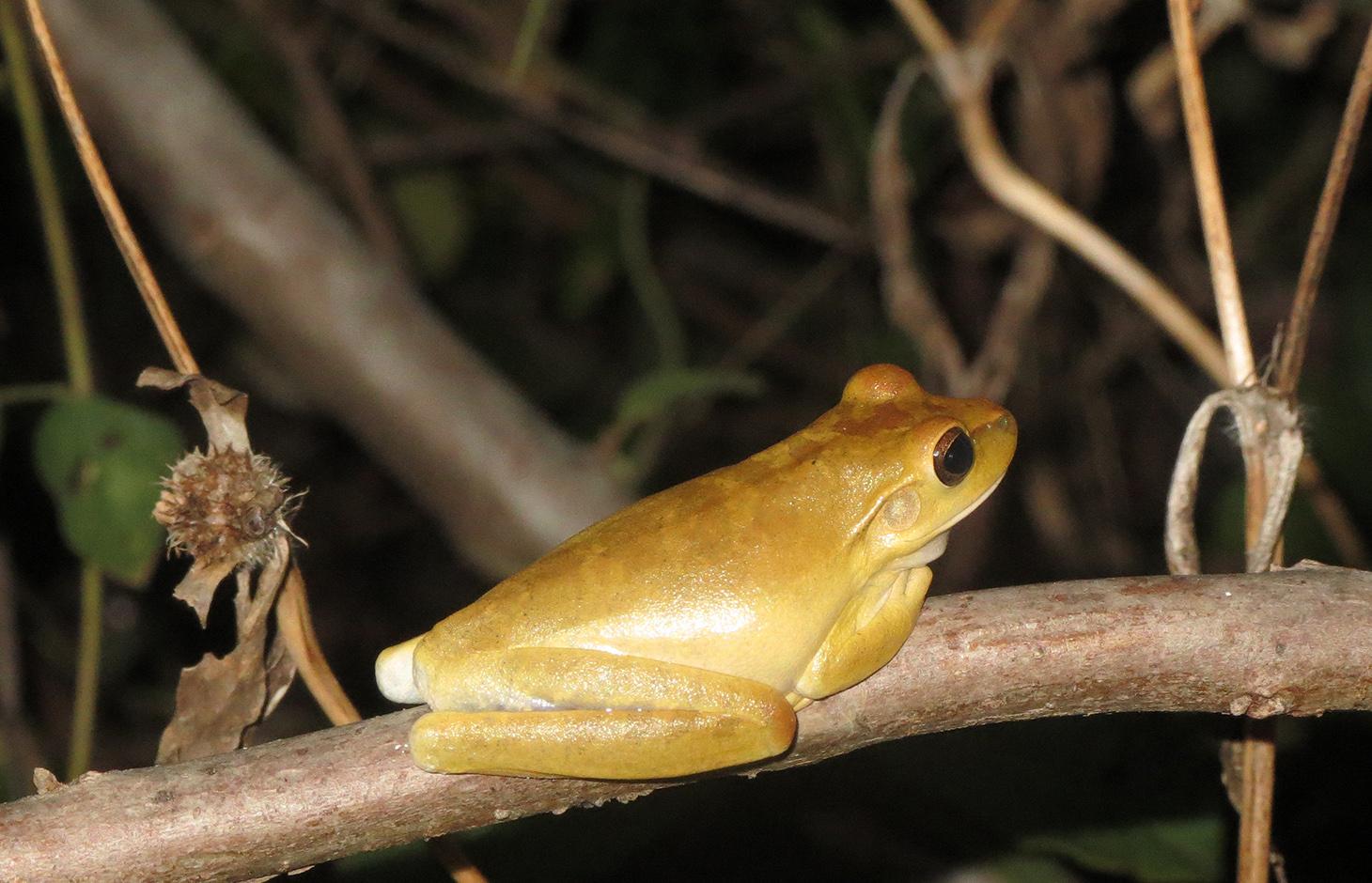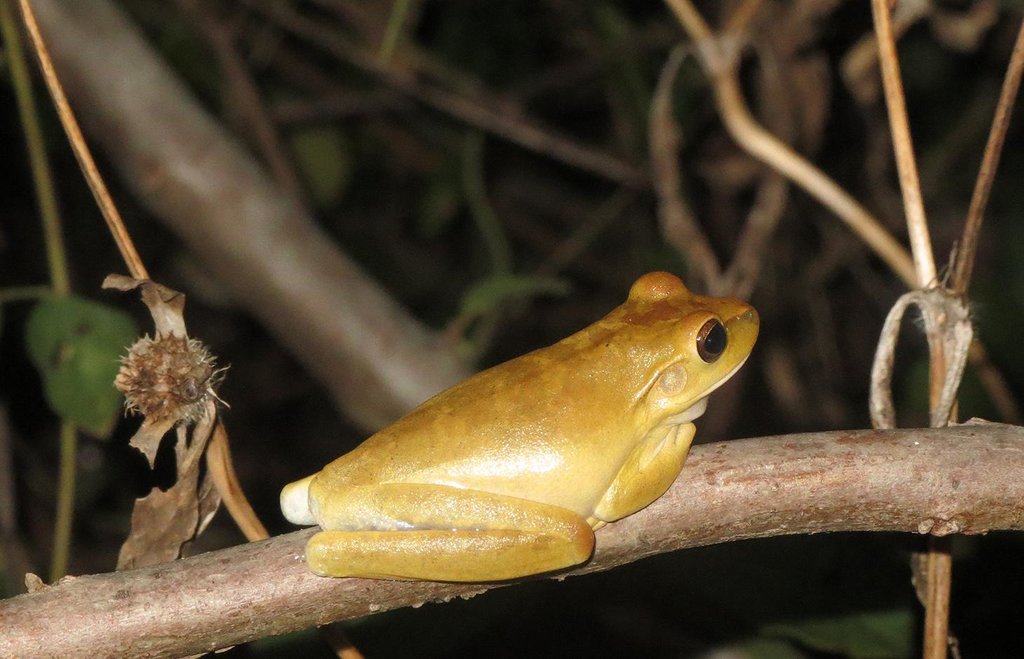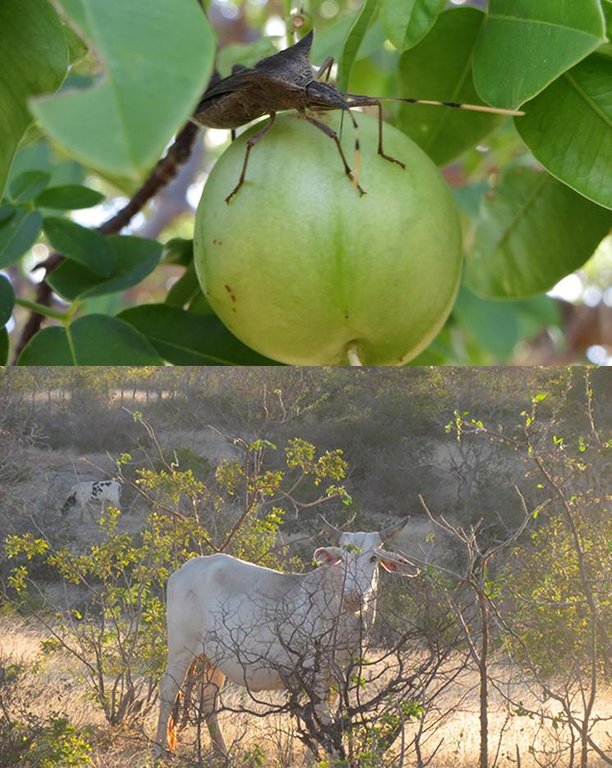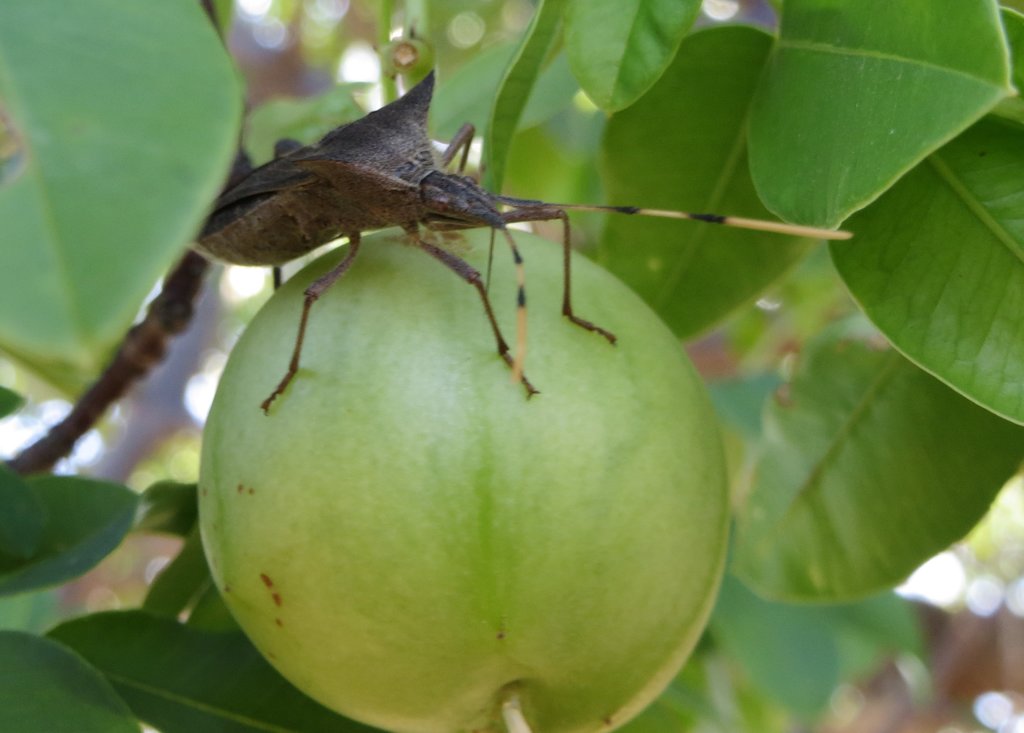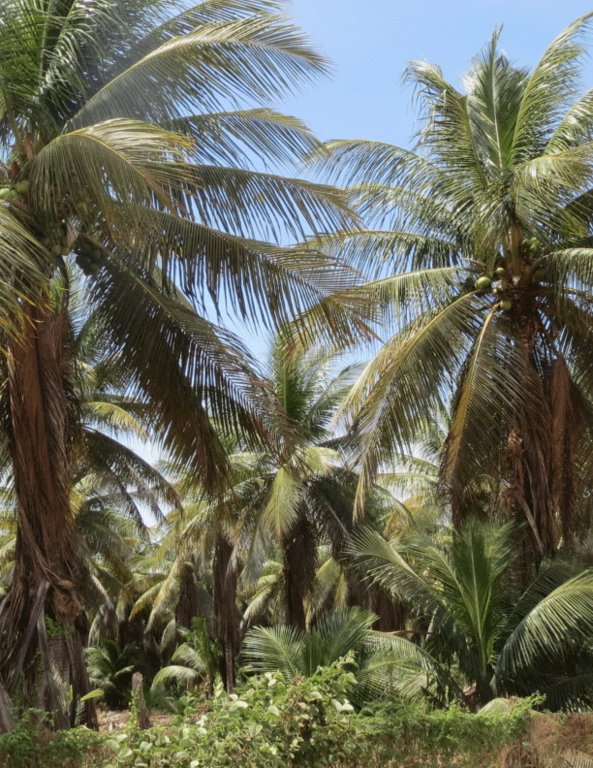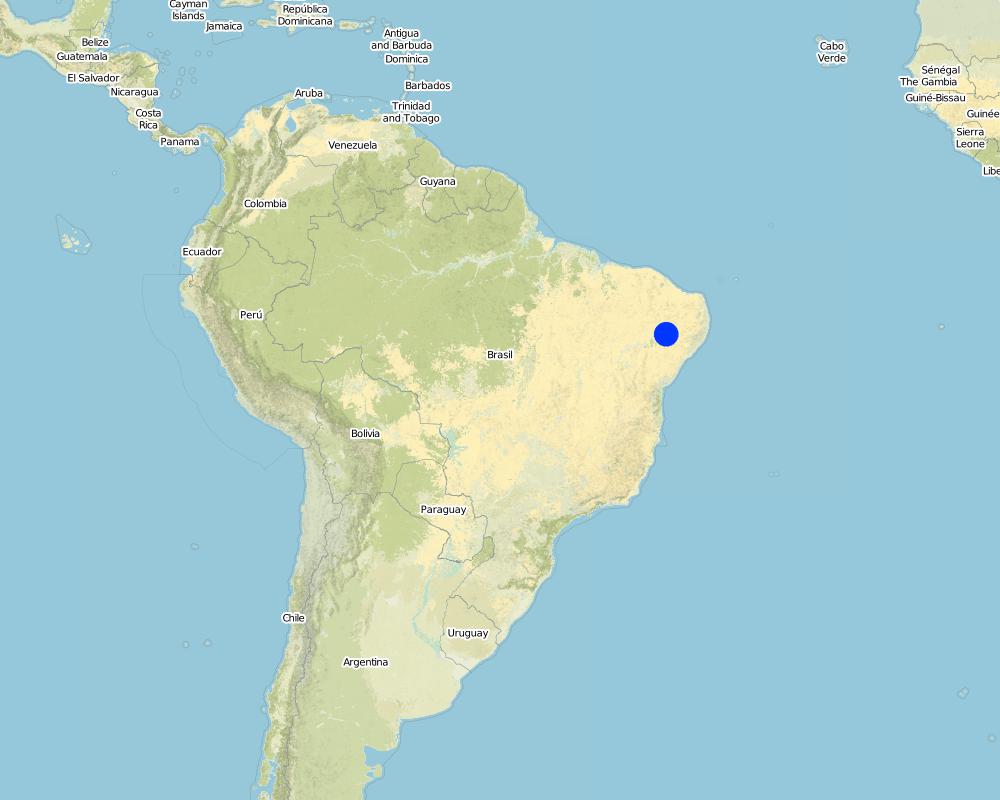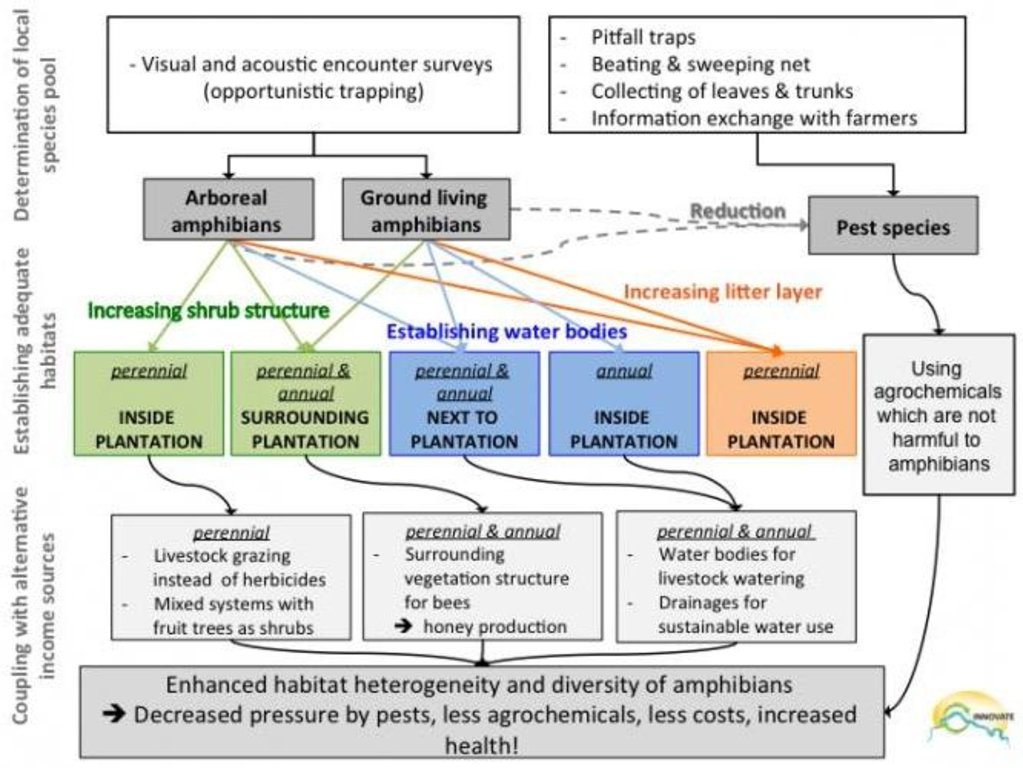Biological pest control through promoting habitats for native fauna [Brésil]
- Création :
- Mise à jour :
- Compilateur : Marianna Siegmund-Schultze
- Rédacteur : –
- Examinateurs : Alexandra Gavilano, Fabian Ottiger, David Streiff
Controle biológico de pragas pela fauna nativa: manter ou restabelecer habitats respectivos (Portuguese)
technologies_1293 - Brésil
Voir les sections
Développer tout Réduire tout1. Informations générales
1.2 Coordonnées des personnes-ressources et des institutions impliquées dans l'évaluation et la documentation de la Technologie
Spécialiste GDT:
Biologist:
Ernst Raffale
Senckenberg Natural History Collections Dresden
Allemagne
Spécialiste GDT:
Hagel Heinrich
Universit of Hohenheim
Allemagne
Nom du projet qui a facilité la documentation/ l'évaluation de la Technologie (si pertinent)
Book project: Making sense of research for sustainable land management (GLUES)Nom du projet qui a facilité la documentation/ l'évaluation de la Technologie (si pertinent)
Interplay among multiple uses of water reservoirs via innovative coupling of substance cycles in aquatic and terrestrial ecosystems (INNOVATE / GLUES)Nom du ou des institutions qui ont facilité la documentation/ l'évaluation de la Technologie (si pertinent)
Universität Hohenheim - AllemagneNom du ou des institutions qui ont facilité la documentation/ l'évaluation de la Technologie (si pertinent)
Senckenberg Natural History Collections Dresden - AllemagneNom du ou des institutions qui ont facilité la documentation/ l'évaluation de la Technologie (si pertinent)
Technische Universität Berlin (Technische Universität Berlin) - AllemagneNom du ou des institutions qui ont facilité la documentation/ l'évaluation de la Technologie (si pertinent)
Leibniz-Institut für Gewässerökologie und Binnenfischerei (IGB) - AllemagneNom du ou des institutions qui ont facilité la documentation/ l'évaluation de la Technologie (si pertinent)
Potsdam-Institut für Klimaforschung (PIK) - Allemagne1.3 Conditions relatives à l'utilisation par WOCAT des données documentées
Le compilateur et la(les) personne(s) ressource(s) acceptent les conditions relatives à l'utilisation par WOCAT des données documentées:
Oui
2. Description de la Technologie de GDT
2.1 Courte description de la Technologie
Définition de la Technologie:
Reducing the use of common agrochemicals by supporting preferred habitats of biological pest control agents like amphibians and by using alternative self-made organic pesticides.
2.2 Description détaillée de la Technologie
Description:
Irrigated crops attract various pest species. Farmers usually address crop pest and disease problems through the use of agrochemicals. Especially bees, birds, and amphibians, which fulfil important functions in agroecosystems, are affected by high use of agrochemicals. The combination of inappropriate irrigation practices, incorrect application rates of agrochemicals, and low producer prices often lead, however, to poor income from smallholder irrigated agriculture and to further problems such as poor health, loss of biodiversity, and soil and water contamination. Amphibians are themselves proven biological pest control agents of arthropod pest species (predators of e.g. larvae of butterflies, beetles, termites, bugs and others) and the incorrect use of agrochemicals, as well as the removal of vegetation along field margins hampers this useful function. The technology described here aims to support and utilise the potential of amphibians (such as frogs and toads) as biocontrol agents –as an alternative to agrochemicals in crops.
Purpose of the Technology: Establishing habitats for amphibians is crucial in order to increase and secure their numbers: for example encouraging shrubby vegetation next to water bodies for arboreal frogs, and installing additional water ponds inside and around plantations for ground-living frogs. First, the local species pool of amphibians needs to be determined by visual and acoustic observations. Amphibian species do not need to be determined precisely, but it is important to detect whether they are arboreal and/or ground-living amphibians, as these two groups have different roles as biocontrol agents. Pests that feed on the main cultivated species should be characterized by (a) collecting plant material to determine the type and quantity of pests and (b) by comparing observations with neighbouring farmers and extension agents. Pest species can be determined also by installing traps and using nets. Inspection should be done at least every 15 days to once a month during the whole rainy season to detect possible mass reproduction of arthropods after rainfall events. Once amphibians and pest species are detected, decisions on management strategies can be made. Such a strategy is to create habitats for amphibians with additional sources of income, e.g. by planting pomegranate or guavas as shrubby vegetation structure for arboreal frogs. If pest species can't be reduced solely by amphibian species, the use of agrochemicals has to be reconsidered. Preference shall be given to chemicals which do not harm amphibians. Organic, self-made pesticides based on the extract of manioc roots (manipoera) seem promising. Twenty litres of manipoera, the bark of manicoba tree (Manihot pseudoglaziovii), a cup of American wormseed (Dysphania ambrosioides), a cup of yellow tagetes (Tagetes sp.), a cup of malagueta pepper (Capsicum sp.), garlic and a little bit of bleach have to be chopped, mixed and fermented for 10 days. Application of the final product (25 ml of organic pesticide diluted in 20 l of water) should be done every 8 to 15 days depending on crop species.
Natural / human environment: Increasing habitat heterogeneity stimulates the diversity of amphibians and so a greater number of pest types will be controlled. Combined control by safeguarding natural amphibian habitats and application of organic pesticides is an innovative alternative to the overuse of toxic agrochemicals.
2.3 Photos de la Technologie
2.5 Pays/ région/ lieux où la Technologie a été appliquée et qui sont couverts par cette évaluation
Pays:
Brésil
Région/ Etat/ Province:
Floresta, Itacuruba, Petrolandia
Autres spécifications du lieu:
Brazil, Pernambuco
Spécifiez la diffusion de la Technologie:
- répartie uniformément sur une zone
S'il n'existe pas d'informations exactes sur la superficie, indiquez les limites approximatives de la zone couverte:
- 0,1-1 km2
Commentaires:
The technology was carried out both in a forest system as well as in agricultural areas. An incrasing SLM Technology area is linked to an increasing sampling number.
Map
×2.6 Date de mise en œuvre de la Technologie
Si l'année précise est inconnue, indiquez la date approximative: :
- il y a plus de 50 ans (technologie traditionnelle)
2.7 Introduction de la Technologie
Spécifiez comment la Technologie a été introduite: :
- au cours d'expérimentations / de recherches
3. Classification de la Technologie de GDT
3.2 Type(s) actuel(s) d'utilisation des terres, là où la Technologie est appliquée
Les divers types d'utilisation des terres au sein du même unité de terrain: :
Oui
Précisez l'utilisation mixte des terres (cultures/ pâturages/ arbres):
- Agro-sylvo-pastoralisme

Terres cultivées
- Cultures annuelles
- Cultures pérennes (non ligneuses)
- Plantations d’arbres ou de buissons
Cultures annuelles - Précisez les cultures:
- légumineuses et légumes secs - fèves
- plantes et herbes médicinales/ aromatiques/ pesticides
- plantes à racines et à tubercules - manioc
- légumes - melon, citrouille, courge ou cucurbitacées
- légumes - autres
- légumes - légumes-racines (carotte, oignon, betterave, autres)
Cultures pérennes (non ligneuses) - Précisez les cultures:
- bananier/plantain/abaca
Plantations d'arbres et d'arbustes - Précisez les cultures:
- noix de coco (fruits, fibre, feuilles, etc.)
- raisins
- manguier, mangostane, goyave
Nombre de période de croissance par an: :
- 1
Précisez:
Longest growing period from month to month: January to May

Pâturages
Pâturage extensif:
- Nomadisme
- Pastoralisme de type semi-nomade
- Ranching
Pâturage intensif/ production fourragère :
- Affouragement en vert/ zéro-pâturage
- Prairies améliorées
Type d'animal:
- caprine
- ovins
- cattle

Forêts/ bois
- Forêts (semi-)naturelles/ bois
- Plantations d'arbres, boisements
Forêts (semi-)naturelles/ terres boisées: précisez le mode de gestion:
- Coupes sélectives
- Coupes à blanc
- Cultures itinérantes
Produits et services:
- Bois d'œuvre (de construction)
- Bois de chauffage
- Fruits et noix
- Autres produits forestiers
- Pâturage/ broutage
- Conservation/ protection de la nature
Commentaires:
Major land use problems (compiler’s opinion): Intensive livestock grazing pressure, agriculture and logging of native vegetation are the driving factors behind loss of the Caatinga dry forest. The high use of agrochemicals additionally pollutes soils and watersheds, and probably also decreases local biodiversity. Droughts seem to occur more frequently and these decrease water and food availability for livestock, as well as affecting the local fauna.
Example for establishment of technology within study region: In the irrigation schemes of Petrolândia, Pernambuco, Brazil, the most important arthropod pest species in banana plantation was a weevil (Curculionidae, Coleoptera). The weevil (so called “moleque da bananeira”) attacked the roots of the banana plants, in consequence the plant tumbled down and was lost. As the weevil stays during the day in the ground and only starts moving during the night, it is difficult to combat this pest species by agrochemicals. With an increase of small water ponds with a shore vegetation structure (for example at 2 corners of the plantation) the abundance of ground-living amphibians increases and so the presence of amphibians in the banana plantation which feed on the weevil during the night.
Major land use problems (land users’ perception): Droughts and consequently problems of feeding livestock on natural vegetation (lack of fodder and grazing grounds), deforestation, extensive and inappropriate use of agrochemicals, low producer prices.
Nomadism: goat, sheep, cattle
Semi-nomadism / pastoralism: goat, sheep, cattle
Ranching: goat, sheep, cattle
Cut-and-carry/ zero grazing: goat, sheep, cattle
Improved pasture: goat, sheep, cattle
Mixed: (eg agro-pastoralism, silvo-pastoralism): goat, sheep, cattle
Selective felling of (semi-) natural forests: Yes
Clear felling of (semi-)natural forests: Yes
Shifting cultivation: Yes
Plantation forestry: Yes
Forest products and services: timber, fuelwood, fruits and nuts, grazing / browsing, other forest products / uses (honey, medical, etc.), nature conservation / protection
Livestock is grazing on crop residues
3.4 Approvisionnement en eau
Approvisionnement en eau des terres sur lesquelles est appliquée la Technologie:
- mixte: pluvial-irrigué
3.5 Groupe de GDT auquel appartient la Technologie
- lutte intégrée contre les ravageurs et les maladies (incluant l'agriculture biologique)
- Biological pest control
3.6 Mesures de GDT constituant la Technologie

pratiques agronomiques
- A1: Couverture végétale/ du sol

pratiques végétales
- V1: Couverture d’arbres et d’arbustes
- V2: Herbes et plantes herbacées pérennes

structures physiques
- S3: Fossés étagés, canaux, voies d'eau
- S5: Barrages/retenues, micro-bassins, étangs

modes de gestion
- M2: Changement du niveau de gestion / d'intensification
Commentaires:
Main measures: agronomic measures, vegetative measures, structural measures, management measures
Type of agronomic measures: retaining more vegetation cover
3.7 Principaux types de dégradation des terres traités par la Technologie

dégradation chimique des sols
- Cn: baisse de la fertilité des sols et réduction du niveau de matière organique (non causée par l’érosion)

dégradation biologique
- Bc: réduction de la couverture végétale
- Bh: perte d’habitats
- Bs: baisse de la qualité et de la composition/ diversité des espèces
- Bp: augmentation des insectes nuisibles (ravageurs)/ maladies, baisse des prédateurs

dégradation hydrique
- Hs: changement de la quantité d’eau de surface
Commentaires:
Main type of degradation addressed: Bc: reduction of vegetation cover, Bh: loss of habitats, Bs: quality and species composition /diversity decline, Bp: increase of pests / diseases, loss of predators, Hs: change in quantity of surface water
Secondary types of degradation addressed: Cn: fertility decline and reduced organic matter content
Main causes of degradation:
Direct causes - Human induced: crop management (annual, perennial, tree/shrub) (high use of agrochemicals, degradation of natural habitats), deforestation / removal of natural vegetation (incl. forest fires) (high logging and grazing intensity, no forest area without grazing!), overgrazing (high logging and grazing intensity, no forest area without grazing!)
Direct causes - Natural: change in temperature (droughts become more frequently), change of seasonal rainfall (droughts become more frequently), heavy / extreme rainfall (intensity/amounts) (less rainfall intensity), droughts (droughts become more frequently)
Secondary causes of degradation: urbanisation and infrastructure development (extending farmlands), population pressure (extending farmlands), poverty / wealth (farmers need to use natural resources as livestock fodder), education, access to knowledge and support services (less environmental awareness)
3.8 Prévention, réduction de la dégradation ou réhabilitation des terres dégradées
Spécifiez l'objectif de la Technologie au regard de la dégradation des terres:
- prévenir la dégradation des terres
- réduire la dégradation des terres
Commentaires:
Main goals: prevention of land degradation, mitigation / reduction of land degradation
Secondary goals: rehabilitation / reclamation of denuded land
4. Spécifications techniques, activités, intrants et coûts de mise en œuvre
4.1 Dessin technique de la Technologie
Spécifications techniques (associées au dessin technique):
Vegetation structures surrounding plantations beside waterbodies guarantee the occurrence of arboreal and ground-living amphibians. Arboreal frogs prefer shrubby vegetation. Since mowing or application of herbicides often eliminates shrubs, moderate livestock grazing might be a better option. The additional water bodies outside the plantation can thereby be used for livestock watering, as long as the surrounding vegetation structure is not eliminated through grazing. Fruit trees such as Guava or Pomegranate as shrub structure provide an additional source of income. To ensure the presence of ground-living frogs, smaller water bodies must be promoted within the plantation. Here puddles from leaky irrigation systems seem to be sufficient already.
Only agrochemicals and organic pesticides that are harmless to amphibians should be used as additional chemical pest control.
Date: 2016
Technical knowledge required for field staff / advisors: moderate (kowledge of habitat preference of important species and management issues)
Technical knowledge required for land users: low (kowledge of habitat preference of important species and management issues)
Main technical functions: increase in nutrient availability (supply, recycling,…), increase of biomass (quantity), promotion of vegetation species and varieties (quality, eg palatable fodder)
Secondary technical functions: control of dispersed runoff: retain / trap, control of dispersed runoff: impede / retard, control of concentrated runoff: retain / trap, control of concentrated runoff: impede / retard, control of concentrated runoff: drain / divert, increase of surface roughness, improvement of surface structure (crusting, sealing), improvement of topsoil structure (compaction), stabilisation of soil (eg by tree roots against land slides), increase in organic matter
Retaining more vegetation cover
Material/ species: herbs in planation of coconut, banana, guave, pomegranat etc.
Quantity/ density: dense
Change of land use practices / intensity level: less grazing in forest areas, less grazing at water ponds (fencing of a certain part of the pond), less cutting of shrubs and herbs in crop plantations (near to natural cutting by livestock)
Auteur:
M. Guschal & L. Steinmetz
4.3 Activités de mise en place/ d'établissement
| Activité | Calendrier des activités (saisonnier) | |
|---|---|---|
| 1. | Installing of additional small and large water bodies: a. large ponds outside the plantation (~100 m²/pond, ~ 4 ponds/plantation, one working day per pond) b. smaller ponds for ground-living frogs inside the plantation (one working day/ 5 ha). c. drainages can be installed instead of ponds outside the plantation for sustainable water use (machine rent) | |
| 2. | Large ponds outside the plantation (~100 m²/ponds, ~4 ponds/plantation, one working day per pond) | |
| 3. | Smaller ponds for ground-living frogs inside the plantation (one working day/ 5 ha) | |
| 4. | Drainages can be installed instead of ponds outside the plantation for sustainable water use (machine rent) | |
| 5. | Planting shrubby vegetation or fruit trees outside and inside the plantation. Planting of Guava trees as shrubby vegetation: 25% density compared to Guava monoculture (e.g. 1.25 working days for exclusive Guava plantation) | |
| 6. | As irrigation was free in the study region, there were no costs calculated | |
| 7. | Knapsack sprayer for application of pesticides |
4.4 Coûts et intrants nécessaires à la mise en place
| Spécifiez les intrants | Unité | Quantité | Coûts par unité | Coût total par intrant | % des coût supporté par les exploitants des terres | |
|---|---|---|---|---|---|---|
| Main d'œuvre | Constructing of large ponds | ha | 1,0 | 36,0 | 36,0 | 100,0 |
| Main d'œuvre | Constructing of small ponds | ha | 1,0 | 1,8 | 1,8 | 100,0 |
| Main d'œuvre | Planting 100 Guava tree/ha | ha | 1,0 | 11,25 | 11,25 | 100,0 |
| Equipements | Rent of machine for pond or drainage ditch excavation | ha | 1,0 | 100,0 | 100,0 | 100,0 |
| Equipements | Knapsack sprayer | ha | 1,0 | 90,0 | 90,0 | 100,0 |
| Matériel végétal | Fruit tree seedlings (100) | ha | 1,0 | 75,0 | 75,0 | 100,0 |
| Coût total de mise en place de la Technologie | 314,05 | |||||
| Coût total de mise en place de la Technologie en dollars américains (USD) | 314,05 | |||||
4.5 Activités d'entretien/ récurrentes
| Activité | Calendrier/ fréquence | |
|---|---|---|
| 1. | Monitoring amphibian species at least 3 nights in the rainy season (can be done by the farmer himself) | |
| 2. | Monitoring of pest species (1 hour/ha) at least every 15 days in the rainy season (5 month/year) and once a month in dry season (7 month/year) (can be done by the farmer himself) | |
| 3. | Production and application of organic pesticides (25 ml of organic pesticide diluted in 20 l of water and applied every 8 to 15 days). Note: for commercial pesticides the application costs are the same. | |
| 4. | Application of fertilizer (1 working day/ year) | |
| 5. | Pruning of trees (5.25 working days(/year) |
4.6 Coûts et intrants nécessaires aux activités d'entretien/ récurrentes (par an)
| Spécifiez les intrants | Unité | Quantité | Coûts par unité | Coût total par intrant | % des coût supporté par les exploitants des terres | |
|---|---|---|---|---|---|---|
| Main d'œuvre | Monitoring of frogs | ha | 1,0 | 27,0 | 27,0 | 100,0 |
| Main d'œuvre | Monitoring of pest species | ha | 1,0 | 18,0 | 18,0 | |
| Main d'œuvre | Production and application of organic pesticide | ha | 1,0 | 720,5 | 720,5 | |
| Main d'œuvre | Pruning and fertilizer application | ha | 1,0 | 56,25 | 56,25 | |
| Coût total d'entretien de la Technologie | 821,75 | |||||
| Coût total d'entretien de la Technologie en dollars américains (USD) | 821,75 | |||||
Commentaires:
To calculate the above example a scenario with maximum activities was taken. Any other scenario will be cheaper. Prices are from the year 2013. Real 1 = USD 0.3.. A total of 6 liters of concentrated organic pesticides per hectare per year are needed. This applies for both self-made and commercial pesticides. As commercial organic pesticides cost about USD 36 per liter, farmers spend USD 216 less per year for self-produced organic pesticides. Similarly commercial non-organic pesticides are more expensive compared to self-made organic pesticides. An additional income of USD 120 / ha / harvest were estimated for guava trees even under possible poor conditions like shadow and extensive management. Other additional sources of income are from the sale of self-produced organic pesticides and livestock grazing instead of using herbicides.
5. Environnement naturel et humain
5.1 Climat
Précipitations annuelles
- < 250 mm
- 251-500 mm
- 501-750 mm
- 751-1000 mm
- 1001-1500 mm
- 1501-2000 mm
- 2001-3000 mm
- 3001-4000 mm
- > 4000 mm
Spécifications/ commentaires sur les précipitations:
8 month of drought , 4 months of rain
Zone agro-climatique
- semi-aride
Thermal climate class: tropics
5.2 Topographie
Pentes moyennes:
- plat (0-2 %)
- faible (3-5%)
- modéré (6-10%)
- onduleux (11-15%)
- vallonné (16-30%)
- raide (31-60%)
- très raide (>60%)
Reliefs:
- plateaux/ plaines
- crêtes
- flancs/ pentes de montagne
- flancs/ pentes de colline
- piémonts/ glacis (bas de pente)
- fonds de vallée/bas-fonds
Zones altitudinales:
- 0-100 m
- 101-500 m
- 501-1000 m
- 1001-1500 m
- 1501-2000 m
- 2001-2500 m
- 2501-3000 m
- 3001-4000 m
- > 4000 m
Commentaires et précisions supplémentaires sur la topographie:
Slopes on average: gentle (3-5%), moderate (6-10%), rolling (11-15%), hilly (16-30%)
5.3 Sols
Profondeur moyenne du sol:
- très superficiel (0-20 cm)
- superficiel (21-50 cm)
- modérément profond (51-80 cm)
- profond (81-120 cm)
- très profond (>120 cm)
Texture du sol (de la couche arable):
- grossier/ léger (sablonneux)
Matière organique de la couche arable:
- moyen (1-3%)
- faible (<1%)
Si disponible, joignez une description complète du sol ou précisez les informations disponibles, par ex., type de sol, pH/ acidité du sol, capacité d'échange cationique, azote, salinité, etc.
Soil fertility is: low, very low
Soil drainage/infiltration is: Poor-medium
Soil water storage capacity: low, very low
5.4 Disponibilité et qualité de l'eau
Profondeur estimée de l’eau dans le sol:
> 50 m
Disponibilité de l’eau de surface:
faible/ absente
Qualité de l’eau (non traitée):
faiblement potable (traitement nécessaire)
5.5 Biodiversité
Commentaires et précisions supplémentaires sur la biodiversité:
Species diversity: medium, low
Species richness of the study region depended strongly on habitat heterogeneity.
5.6 Caractéristiques des exploitants des terres appliquant la Technologie
Revenus hors exploitation:
- 10-50% de tous les revenus
Niveau relatif de richesse:
- moyen
Individus ou groupes:
- individu/ ménage
Niveau de mécanisation:
- travail manuel
- traction animale
Genre:
- femmes
- hommes
Indiquez toute autre caractéristique pertinente des exploitants des terres:
Land users applying the Technology are mainly common / average land users
Population density: 10-50 persons/km2
Annual population growth: 1% - 2%
Off-farm income specification: the same, there are just single farmers who use the technology till now
Market orientation of production system: subsistence (self-supply), subsistence (self-supply), subsistence (self-supply), mixed (subsistence/ commercial, mixed (subsistence/ commercial, commercial/ market, commercial/ market
5.7 Superficie moyenne des terres utilisées par les exploitants des terres appliquant la Technologie
- < 0,5 ha
- 0,5-1 ha
- 1-2 ha
- 2-5 ha
- 5-15 ha
- 15-50 ha
- 50-100 ha
- 100-500 ha
- 500-1 000 ha
- 1 000-10 000 ha
- > 10 000 ha
Cette superficie est-elle considérée comme de petite, moyenne ou grande dimension (en se référant au contexte local)?
- moyenne dimension
Commentaires:
Average area of land owned or leased by land users applying the Technology: < 0.5 ha, 0.5-1 ha, 1-2 ha, 2-5 ha
5.8 Propriété foncière, droits d’utilisation des terres et de l'eau
Propriété foncière:
- état
Droits d’utilisation des terres:
- individuel
- official registration and permission
- official registration and permission
5.9 Accès aux services et aux infrastructures
santé:
- pauvre
- modéré
- bonne
éducation:
- pauvre
- modéré
- bonne
assistance technique:
- pauvre
- modéré
- bonne
emploi (par ex. hors exploitation):
- pauvre
- modéré
- bonne
marchés:
- pauvre
- modéré
- bonne
énergie:
- pauvre
- modéré
- bonne
routes et transports:
- pauvre
- modéré
- bonne
eau potable et assainissement:
- pauvre
- modéré
- bonne
services financiers:
- pauvre
- modéré
- bonne
6. Impacts et conclusions
6.1 Impacts sur site que la Technologie a montrés
Impacts socio-économiques
Production
production agricole
production fourragère
production animale
Commentaires/ spécifiez:
high number of livestock will decrease favourable vegetation structure for predators
surface de production
Commentaires/ spécifiez:
loss of land
Revenus et coûts
dépenses pour les intrants agricoles
diversité des sources de revenus
Impacts socioculturels
situation sanitaire
Commentaires/ spécifiez:
Reduced pesticide toxic effect on human health
Improved livelihoods and human well-being
Commentaires/ spécifiez:
Less use of agrochemicals
Impacts écologiques
Biodiversité: végétale, animale
diversité végétale
diversité animale
diversité des habitats
contrôle des animaux nuisibles/ maladies
6.2 Impacts hors site que la Technologie a montrés
inondations en aval
6.3 Exposition et sensibilité de la Technologie aux changements progressifs et aux évènements extrêmes/catastrophes liés au climat (telles que perçues par les exploitants des terres)
Changements climatiques progressifs
Changements climatiques progressifs
| Saison | Augmentation ou diminution | Comment la Technologie fait-elle face à cela? | |
|---|---|---|---|
| températures annuelles | augmente | bien |
Extrêmes climatiques (catastrophes)
Catastrophes météorologiques
| Comment la Technologie fait-elle face à cela? | |
|---|---|
| pluie torrentielle locale | pas bien |
| tempête de vent locale | bien |
Catastrophes climatiques
| Comment la Technologie fait-elle face à cela? | |
|---|---|
| sécheresse | pas bien |
Catastrophes hydrologiques
| Comment la Technologie fait-elle face à cela? | |
|---|---|
| inondation générale (rivière) | bien |
Autres conséquences liées au climat
Autres conséquences liées au climat
| Comment la Technologie fait-elle face à cela? | |
|---|---|
| réduction de la période de croissance | bien |
Commentaires:
As amphibians depend in their abundance and species composition on the rainfall amount and intensity the technology is sensitive for changing rainfall events by increasing abundance of amphibians with higher rainfall amount and so probably a better pest control.
In case of frequent droughts, reptiles like lizards get more important as they do not depend so strong on rainfall events like amphibians.
6.4 Analyse coûts-bénéfices
Quels sont les bénéfices comparativement aux coûts de mise en place (du point de vue des exploitants des terres)?
Rentabilité à court terme:
négative
Rentabilité à long terme:
positive
Quels sont les bénéfices comparativement aux coûts d'entretien récurrents (du point de vue des exploitants des terres)?
Rentabilité à court terme:
légèrement négative
Rentabilité à long terme:
positive
6.5 Adoption de la Technologie
Commentaires:
There is no trend towards spontaneous adoption of the Technology
Comments on adoption trend: Technology is still in the testing phase and it is too early to give any data on acceptance or adoption
6.7 Points forts/ avantages/ possibilités de la Technologie
| Points forts/ avantages/ possibilités du point de vue du compilateur ou d'une autre personne ressource clé |
|---|
|
A strong advantage is the low cost of this ecosystem service which is provided almost freely to farmers, especially when the potential for pest control (abundancy of useful amphibians) is high enough to eliminate the need for agrochemicals. How can they be sustained / enhanced? Establish adequate habitats to maintain high diversity of the relevant reptiles and amphibians. |
|
Less use of agrochemicals results in a healthier environment for producers and consumers How can they be sustained / enhanced? If the potential of the reptiles and amphibians is not high enough to combat all pest species, organic chemicals or alternative biocontrol species could be used (for example horntails etc.). |
|
Changing monoculture to mixed systems - or even agropastoral systems - offers additional income sources, while diversification often as a buffer to sudden drops in the price of a particular crop How can they be sustained / enhanced? The crop mixture needs to be well designed, to ensure that the harvests of important crops are not affected too much, and the reduction compensated for by the others. |
6.8 Faiblesses/ inconvénients/ risques de la Technologie et moyens de les surmonter
| Faiblesses/ inconvénients/ risques du point de vue du compilateur ou d'une autre personne ressource clé | Comment peuvent-ils être surmontés? |
|---|---|
| Droughts and limited water availability influence species richness of amphibians. | Providing sufficient water bodies for amphibians to outwear heavy droughts is recommended. |
7. Références et liens
7.1 Méthodes/ sources d'information
7.2 Références des publications disponibles
Titre, auteur, année, ISBN:
): Guschal & Hagel et al. Benefits of site-adapted management (pest-control) innovations in northeastern Brazil.
Disponible à partir d'où? Coût?
In preparation
Liens et modules
Développer tout Réduire toutLiens
Aucun lien
Modules
Aucun module trouvé


